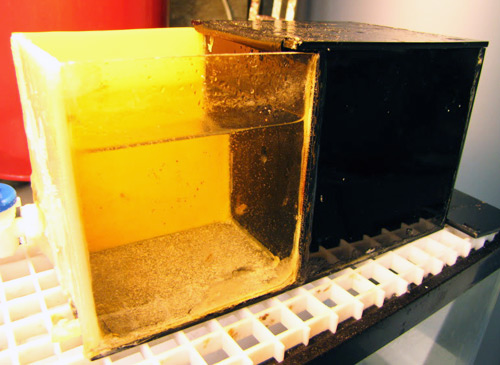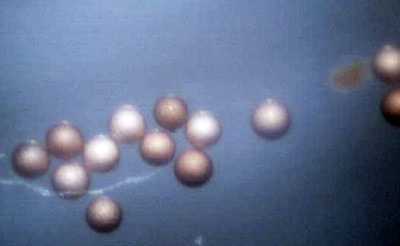Adult brine shrimp are not considered a good source of food for any fish, but they are sometimes used to entice a slow eater to start eating. Newborn brine shrimp, however, are an excellent source of food for many small fish, such as mandarins and pipefish. Those fish need a constant supply of live food as they were built to eat small, live morsels of food continuously throughout the day, and in an aquarium we should try to satisfy that need.
What’s a “pod”?
We aquarists tend to call any tiny marine creature a “pod,” but there really are miniscule crustaceans called amphipods and copepods and it’s these creatures and other tiny invertebrates that these fish normally live on.
The benefits of baby brine shrimp
Notwithstanding their natural diet, newborn brine shrimp may, in fact, be a better source of food than real pods. A pod is an adult animal with nutritious internal organs, but a newborn brine shrimp has something extra; a large portion of a newborn brine shrimp is yolk sac, which is mostly oil and brimming with fat and nutrition.
In a day or so, all that nutrition is absorbed into the shrimp to be used for energy. After that, they aren’t much better than adult brine shrimp, so we want to give them to our fish as soon as they are born. We want that energy to go into our fish.
Acquiring the eggs
Brine shrimp eggs are readily available in aquarium stores or online, and they are relatively inexpensive. Other seasoned salties out there will recall that they were once sold as “sea monkey eggs.”
The eggs can last for many years as long as they are kept dry and not too hot, and when they are added to seawater, they start to hatch in a little more than a day. We don’t want to just dump the eggs in our aquariums, however. We need to eliminate the shells first.
Hatchery design
 I designed the feeder shown here, but you can buy various versions from numerous sources. My design consists of a plastic container that is composed of two compartments. One side is black, and the other side is clear, but both sides could be black. (A clear container with the outside spray painted black could be used.) Separating the two sides is a barrier with an approximately 3/8” hole in it. You need some means to temporarily close that hole, so I added a sliding door for that purpose.
I designed the feeder shown here, but you can buy various versions from numerous sources. My design consists of a plastic container that is composed of two compartments. One side is black, and the other side is clear, but both sides could be black. (A clear container with the outside spray painted black could be used.) Separating the two sides is a barrier with an approximately 3/8” hole in it. You need some means to temporarily close that hole, so I added a sliding door for that purpose.
Hatching the eggs and separating the shells
Here are the steps for hatching the brine shrimp, separating the babies from the eggs, and feeding the nutritious shrimp to your fish:
- Fill both compartments with sea water, which could be old tank water.
- Add about 1/4 teaspoon of brine shrimp eggs (or a little more) to the darkened compartment. Aerate the darkened compartment with a small air pump. The eggs hatch better with some aeration, but they will also hatch without it.
- In about 36 hours, the eggs will be hatched and you can remove the aeration and slide open the door (or remove whatever means you used to plug the hole).
- Place a dark cover over the compartment with the eggs in it.
- Put the container in the light, or place a small light over the uncovered compartment of the device. The shrimp will be attracted to light, so in about 15 minutes, all the shrimp will be in the lighted compartment and all the egg shells will be left behind in the darkened compartment.
- Slide closed the door, and siphon out the water and shrimp. If you prefer, you can also install a valve on the shrimp side for easier draining.
- Finally, go ahead and pour the water and brine shrimp into your tank or strain out most of the water and pour the shrimp into a feeder, such as the one I recently wrote about. I find it’s best to use a feeder. Otherwise, their habit of being attracted to light will cause all the brine shrimp to swim to the surface of the tank and into your overflow.
Final food for thought
I have been hatching brine shrimp all my life (and I am old). Without this excellent source of food, I would not be able to keep fish such mandarins and bluestripe pipefish, let alone have them spawn continuously in my tank.
An old tank such as mine has an ample supply of pods, but with this extra food source, I am assured that these types of fish get enough to live a long and, I assume, happy life.




Do you have to maintain a certain temp of the water for them to hatch?
They hatch at room temperatire, about 70 degrees. If it is a little warmer, they hatch a little faster.
I think my DIY chiller is on here someplace. Search my name
Do eggs have an expiration date?
I don’t remember how long it took to make as I made a bunch of them. It probably started out as something else, then it was re designed to become what it is. Many of the things I build eventually have new lives. MY DIY chiller used to be a wet dry filter and my fish fry collector used to be a HOB filter.
Do you have a link or photos of your DIY chiller? I’d like to make one
how long did it take you to make this ?
It’a about 4x4x8″ but I also have a larger one. You can make it any size depending on how many shrimp you need.
I hatch them every day but I start the batch in another container the day before so I always have enough shrimp
Ok thanks I think I might try it out and see if I can make one
Thanks for the reply
Don
How big is the box that you made for your hatchery ?
Room temperature is fine
Do you need to keep the water within a range of temperature or is room temperature adequate?
Couldnt someone just put the eggs in a bowl in a low flow area of the sump?
Yes, you could also pour them in your reef but those egg slells do not disintegrate and they will be floating around in your tank for a long time. You need to hatch the shrimp and then seperate them from the shells. Just like we don’t put in the entire egg when we bake a cake, we remove the shell.
About half of the brine shrimp eggs float for some reason and would all just go into your skimmer.